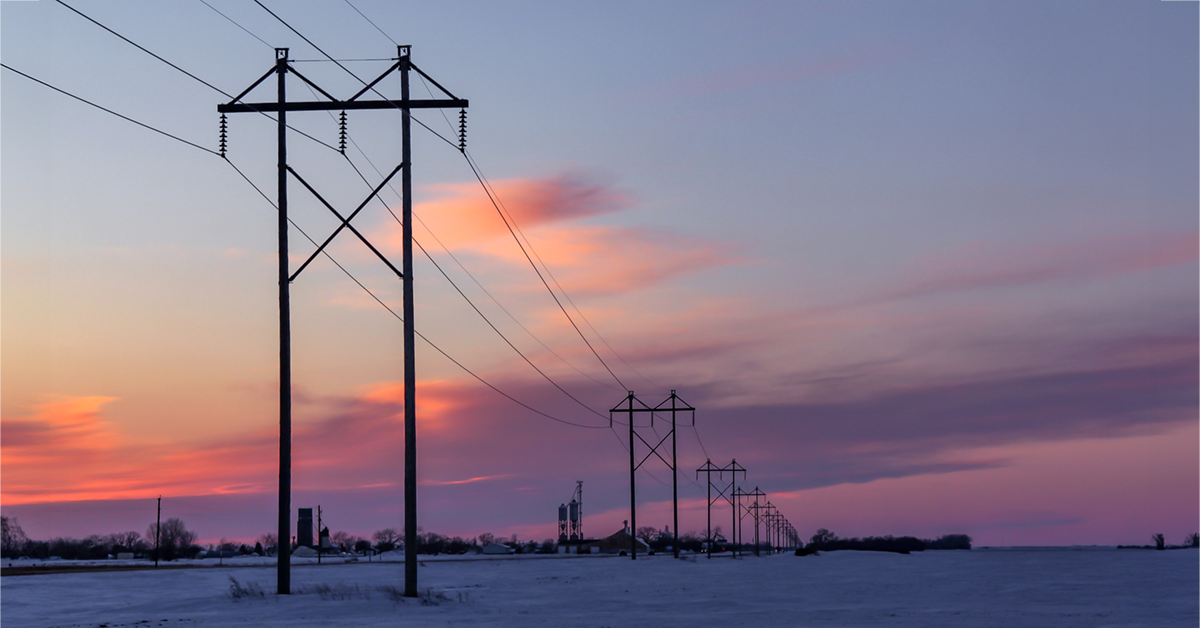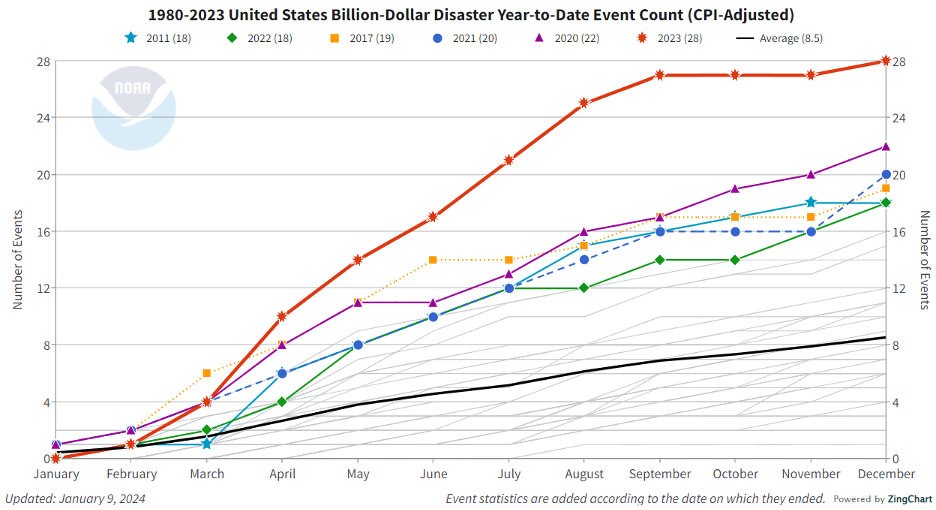
The devastating wildfire in Maui. Floods in California. A historic heat wave in the southern U.S. Multiple tornados and hailstorms in the Midwest.
2023 was a year of weather and climate disasters. And while we rightfully tend to focus on the destruction and human tragedy that occurs, it’s important to take a look at what this means for the nation’s electric grid, too. Floods can damage underground transformers, while hurricanes and blizzards often take out utility poles and power lines. And beyond the physical challenges our grid faces in harsh conditions, times of excess heat or cold quickly lead to customer demand spikes, which creates a whole new slew of problems.
Even a robust grid would struggle to withstand this meteorological onslaught, and the U.S. electric grid is unfortunately not as robust as we would like. In fact, it has been described as brittle. And as it’s facing these challenges, it continues aging while receiving little relief. According to the U.S. DOE, 70% of transmission lines and power transformers are at least 25 years old.
Despite the deadly combination of aging and a relentless assault of extreme weather conditions, our beleaguered grid has held up thus far. Vox reports that on July 27, 2023, in the hottest month since 1880, electric grids delivered the highest U.S. energy demand ever recorded: an hourly peak of 741,815 MWh.
We can thank two main factors for driving our grid forward during tumultuous times:
- Forecasters predicted a scorching summer in advance, giving utilities time to plan for energy use and alert customers.
- Renewable energy, especially solar and wind power, has required utilities to fortify the grid for greater flexibility.
Utilities’ Role in Grid Reliability
The good news is that our grid has made it this far. But the bad news is that these climate catastrophes are likely to continue and increase in frequency, delivering even greater risk.
Grimly, 2023 set a new U.S. record with 28-billion-dollar disaster events, adjusted for inflation; for context, our historic average since 1980 has been less than nine. However, occurrences have increased dramatically, bringing our average up to 20 events in the last five years. According to the National Oceanic and Atmospheric Administration’s (NOAA) National Centers for Environmental Information, this “consistent pattern…is becoming the new normal.”

Image Source: Climate.gov
On its own, the increasing frequency and intensity of our weather and climate disasters is cause enough for concern. Layer in the problems they cause for the electric grid—and the future of building and transportation electrification—and there’s a major opportunity.
All hope isn’t lost yet. With thoughtfulness and planning, utilities can make grids more resilient and support the nation’s transition to a sustainable, electrified future. Here are three key ways to do it.
- Increase Reliance on Distributed Energy Resources
Distributed energy resources (DERs)—particularly distributed generation, battery storage, smart charging, and advanced metering infrastructure—are already a staple for many utilities.
At the DOE’s Electricity Advisory Committee (EAC) meeting in June of 2023, it was noted that before a utility can truly become DER-centric, it must address generation, planning, operations, and customer programs. This sounds like a tall order, but thankfully these components go hand-in-hand.
The traditional approach to generation planning includes an integrated resource plan (IRP) with a demand-side management (DSM) component. In truth, DSM is typically heavily discounted by resource planners because of its traditional uncertainty. A DER-centric approach instead, makes cost-effective DERs part of the IRP process and a reliable resource. This is because DERs happen at a known time, at a known place, on a specific meter. DERs is DSM with the receipts.
- Deliver Value in a Dynamic Grid
Different states have different utility load-management standards which are based upon a variety of conditions. Not surprisingly, California, which has pledged that two-thirds of its electricity will be generated by renewable energy by 2023, has some of the most stringent standards.
California’s load-management requirements for large utilities and community-choice aggregators include various components to enable real-time (retail) pricing, including:
- Detailing rates in the publicly available and machine-readable Market Informed Demand Automation Server (MIDAS) database
- Developing a standard-rate information-access tool for third-party services
- Developing locational rates that change at least hourly to reflect marginal wholesale costs
- Including information about new time-varying rates and automation technologies in customer education and marketing materials
As utilities gain more accurate visibility into the time-value of energy saved, Franklin Energy has been at the forefront in delivering programs with grid value. Here’s how we helped a large California utility leverage residential measured pay-for-performance to reduce peak consumption when the grid is typically most at risk.
- Leverage Demand Response
With proper standards, demand response programs are able to support the shift to sustainable energy while improving grid reliability in two important ways:
- Empowering customers to manage their power consumption (and costs) during peak-demand periods
- Allowing greater amounts of renewable energy into the grid by aligning customer demand with resource availability
As the energy landscape continues to evolve, demand response will play an even more significant role in grid management. The integration of advanced technologies such as smart grids, IoT devices, and machine-learning algorithms will further optimize demand response programs, enabling more accurate forecasting and real-time adjustments.
While configuring demand response programs may appear complicated on the outset, it doesn’t need to be. Here’s an example of how Franklin Energy helped a large Missouri utility implement Peak Time Savings, a demand response program that adjusts customers’ smart thermostat settings during weather events.
Bringing It All Together
Let’s look at a real-world example. When a West Coast utility was faced with aging power lines in a high wildfire-risk area that served isolated buildings in a wilderness preserve, they turned to integrated DERs to solve their challenge. With our team’s assistance, the small buildings were taken off the grid rather than attempt to reinforce them against environmental degradation. The result was a fast, low-cost solution with fewer environmental risks—and consistent renewable energy for the buildings. Read more about this initiative here.
The Bottom Line
Thanks to an increased frequency in high-impact weather and climate disasters, our aging U.S. electric grids are facing more pressure than ever before. But even though the outlook may sound bleak, utilities don’t need to be the victim of grid unreliability. There are a variety of programs that can help combine DERs, leverage demand response measures, and deliver value to keep utilities’ futures looking bright. Contact Franklin Energy to learn how our programs can help you navigate our evolving environment and manage the grid of the future.

.png)
.png)


.png)
